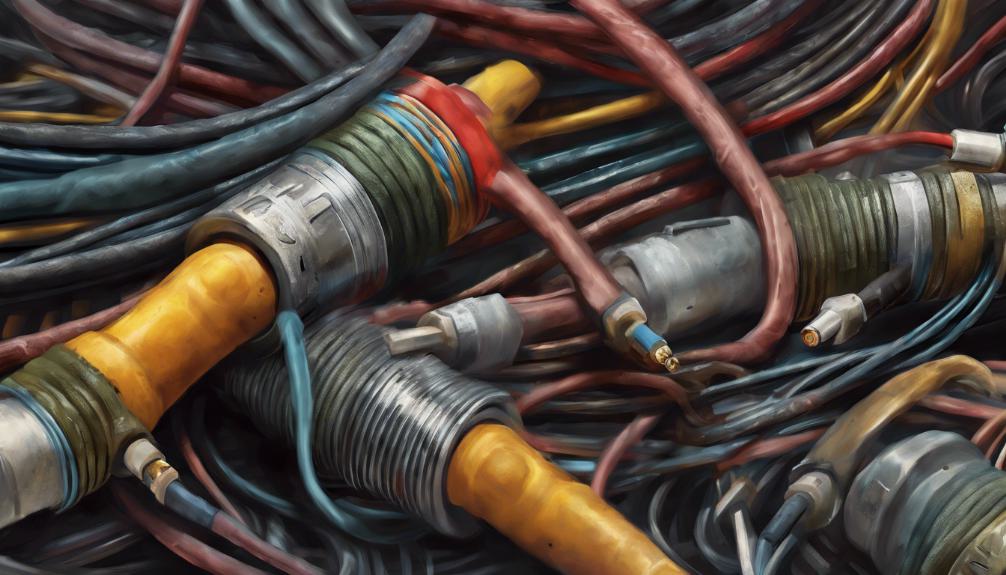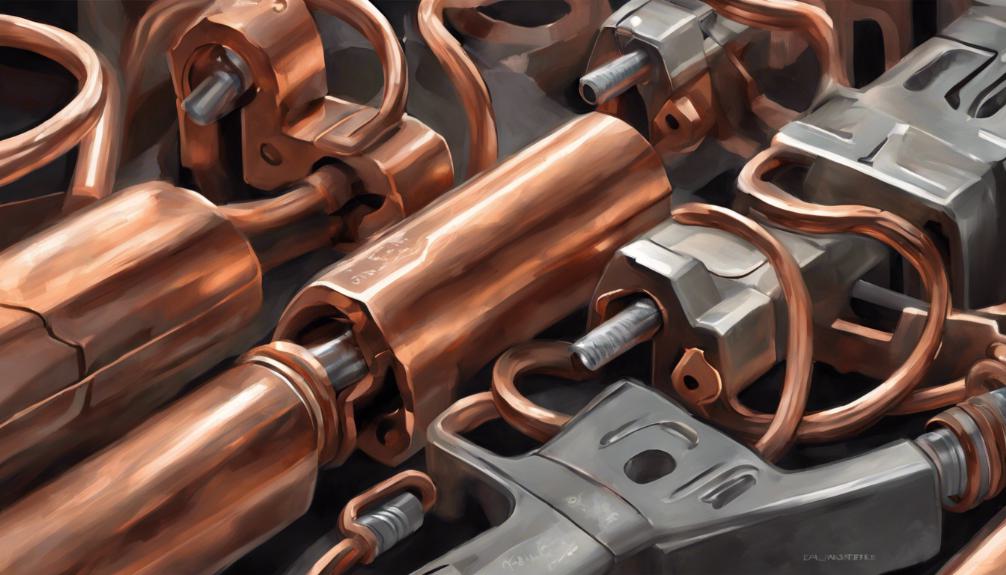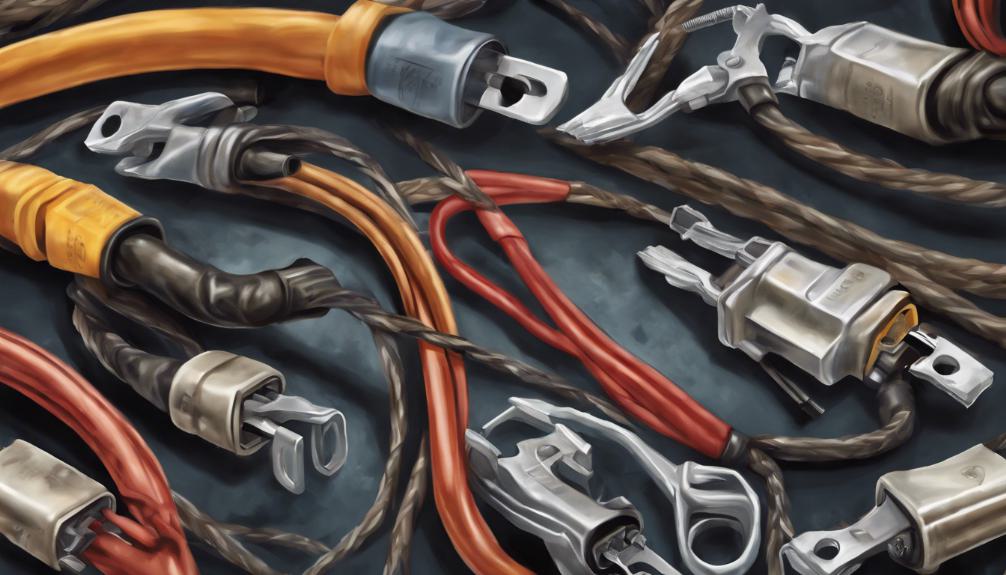When it comes to jumper cables, knowing the right gauge, length, and clamps can make all the difference in a successful jump-start.
The gauge determines power capacity, the length offers flexibility, and copper clamps guarantee a secure connection.
But what about the lesser-known factors that can impact performance and safety?
What You Need to Know
- Opt for 4 or 6-gauge cables for higher power capacity.
- Choose appropriate cable length for flexibility and reach.
- Copper clamps ensure efficient electricity transfer and durability.
- Thicker wire and longer cables enhance conductivity and usability.
- Balance power needs with cost-effectiveness for optimal performance.
Importance of Jumper Cable Gauge

Understanding the importance of jumper cable gauge can greatly impact your ability to efficiently jump-start vehicles.
The gauge of the jumper cable wire plays a significant role in determining its amperage capacity, which directly affects its effectiveness in providing the necessary power to start a vehicle.
Lowering the gauge of the jumper cable, such as opting for a 4 or 6-gauge jumper cable, guarantees that you have sufficient power transfer for jump-starting standard vehicles.
Thicker gauge cables, like those with lower numbers such as 4, offer higher power capacity, allowing for quicker jump-starts and better electricity flow to the battery.
For larger vehicles, it’s recommended to use 1 or 2-gauge cables to accommodate the increased power requirements.
By choosing the right gauge jumper cable for the specific vehicle you’re jump-starting, you can ensure a successful and efficient jump-start process with excellent power transfer.
Choosing the Right Cable Length
When considering the right cable length for jump-starting vehicles, selecting the appropriate jumper cables is crucial in providing flexibility and convenience during the process.
There’s a wide variety of cable lengths available, ranging from shorter 10-foot options to longer 20-foot cables.
For portable jump-starting needs, a 10-foot cable may be sufficient, especially in face-to-face parking situations where vehicles are parked closely together.
However, if you often find yourself needing to jump-start a vehicle from behind or in tight spots where maneuvering is limited, a longer 20-foot cable can be more beneficial.
The thicker the wire, the better the conductivity, so keep in mind that the gauge of the cable also impacts its effectiveness.
Selecting the right cable length ensures that you have the necessary reach to connect to battery terminals in various positions or locations, offering you convenience and ease of use during jump-starts.
Benefits of Copper Clamps

Copper clamps significantly enhance the efficiency and reliability of jump-starting vehicles by providing excellent conductivity and durability.
When dealing with a dead battery, efficient electricity transfer is vital for a successful jump-start.
Copper clamps excel in this aspect, guaranteeing that power flows smoothly from the working battery to the dead one, facilitating a quick restart.
On top of that, copper’s resistance to corrosion ensures long-lasting performance, unlike other materials that may wear down quickly, leading to poor connections and reduced effectiveness during jump-starts.
The superior conductivity of copper not only enables efficient electricity transfer but also improves the overall safety of the jump-starting process.
By providing a secure and stable connection with the battery terminals, copper clamps minimize the risk of power loss or unreliable contact.
Investing in jumper cables equipped with copper clamps is a wise choice to make sure that you can confidently tackle any dead battery situation with ease and effectiveness.
Understanding Gauge Power Capacity
For peak jump-starting performance, consider the power capacity of the jumper cable gauge.
The gauge of jumper cables typically ranges from 1 to 12, with lower numbers like 4-6 gauge being recommended for standard vehicles due to their higher power capacity.
Thicker gauge cables, such as 1-2 gauge, are more suitable for larger vehicles that require extra power for jump-starting.
Lower gauge cables allow for quicker jump-starts and come with better quality clamps that guarantee efficient electricity transmission.
To make sure you have enough power to jump-start your vehicle, opt for 4-6 gauge jumper cables as they strike a balance between power needs and cost-effectiveness for most vehicles.
Understanding the jumper cable gauge is essential in selecting the right cables based on the power requirements of your vehicle.
Can Jumper Cables be Used to Check Fuel Gauge Operation?
Yes, jumper cables can be used to check fuel gauge operation basics. By connecting the positive and negative ends of the jumper cables to the corresponding terminals on the fuel gauge, you can test whether the gauge needle moves to the correct position. However, caution is advised when attempting this.
Factors Influencing Cable Performance

To understand what influences the performance of jumper cables, consider the impact of various factors on their effectiveness and reliability. The set of jumper cables you choose can greatly affect the outcome of your jump-start.
The last thing you want is to be stranded with ineffective cables when a reliable set might save you in a pinch.
Thicker gauge cables, specifically at a gauge of 4 or better, allow for quicker jump-starts and better power transmission.
Copper clamps play an important role in providing efficient electricity transfer and durability compared to other materials.
Also, thicker wire in jumper cables enhances insulation and flexibility, making them suitable for various weather conditions.
Longer cable lengths, such as 20 feet, offer easier battery-to-battery connections and reduce accidents during jump-starts.
For top performance, make sure you use a gauge of at least 4, quality clamps, and a suitable cable length for safety and convenience.
Tips for Reliable Jump-Starts
When jump-starting a vehicle, make sure you select the appropriate gauge jumper cables for best power transfer. To guarantee a reliable jump-start, consider the following tips:
- Choose the Right Gauge: Use 4 to 6-gauge jumper cables for standard vehicles for sufficient power transfer.
- Invest in Quality Clamps: Opt for thicker gauge cables with quality clamps for quicker jump-starts and reliable connections.
- Opt for Copper Clamps: Copper clamps resist corrosion and conduct electricity efficiently for a secure jump-start.
- Consider Cable Length: Longer cables offer flexibility in battery-to-battery connections, especially in challenging situations.
- Secure the Clamps Properly: Quality clamps are essential for a secure grip on battery terminals, especially the negative terminal, ensuring a successful jump-start.
As an Amazon Associate we earn from qualifying purchases.










